<< BACK TO PROJECT LIST
Project: 297/2014
Title: The role of colonisation in establishment of self-sustaining populations of rare terrestrial orchids – a template study for establishing principles to guide translocation and conservation programs.
Applicant: Professor Dorset W. Trapnell
Institution: (University of Georgia USA), Kings Park and Botanic Garden, West Perth
Orchid genera pollinated by sexual deception show higher levels of intrinsic rarity than those pollinated through other strategies. Of the 82 species of Western Australian orchids considered rare, 37 are pollinated by sexual deception. Persistence of populations and species depends on demographic stability or growth of existing populations, as well as the ability to disperse, colonise and establish new populations in unoccupied habitat. Understanding the mechanisms that underlie these critical processes is essential for implementation of effective conservation strategies and restoration practices. However, little is presently known about the patterns and mechanisms of colonisation and population growth in any Australian orchid species, with this information being critical for advancing the theory and practice of conservation biology of terrestrial orchids. The genus Drakaea is ideal for this study because its species often colonise disturbed sites, providing young populations that are particularly valuable for addressing these questions and the application of this novel analytical approach.
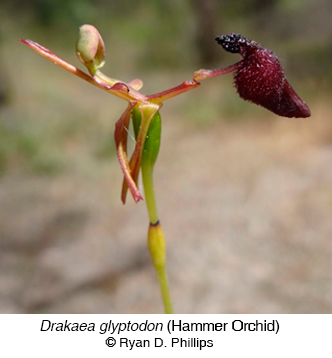
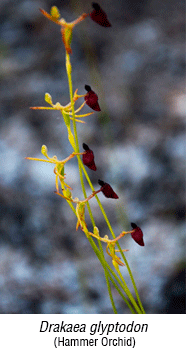
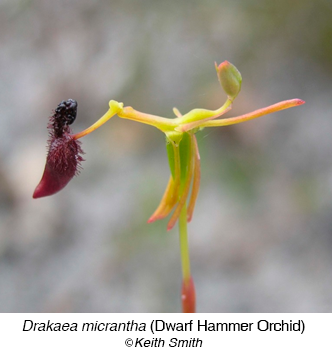
Research outcomes
- Many species of orchid occur in small populations, either naturally or through the effects of anthropogenic landscape modification. This raises the question of how these populations are formed and how they persist? Resolving this question could be important for both management of rare species, and optimising the process of conservation translocations.
- In this project we focused on two species of hammer orchid, the common Drakaea glyptodon and the rare Drakaea micrantha. We used nuclear DNA microsatellites and chloroplast DNA haplotypes to investigate genetic characteristics of populations from natural habitats and those that are the product of disturbance. Ideally, this approach would allow us to both compare the characteristics of older vs newly initiated populations, and to investigate the number of seed parents contributing the formation of new populations. The genetic data could also be used to investigate patterns of genetic differentiation between populations, and the relative contribution of gene flow from pollen vs seed.
- For both species, all populations regardless of size had high levels of genetic diversity, suggestive of well-established populations. Our estimated number of effective seed parents was generally high, suggesting that a large number of seed arrival events were associated with colonisation. However, the unexpected age of all populations violates some assumptions of this approach, meaning that caution is needed when interpreting these estimates.
- Genetic variation between populations in both species was relatively low, suggestive of high gene flow. Quantifying genetic differentiation for both nuclear (inherited from both parents) and chloroplast DNA (maternal inheritance) allows comparison of the contribution to gene flow of pollen vs seed dispersal. Like most flowering plants, gene flow via pollen was more extensive than via seed. This finding is somewhat at odds with what is known about the biology of the thynnnine wasps that pollinate Drakaea. However, this pattern may be explained by regular movement of pollen between neighbouring populations of orchid.
- While the apparent age of the populations unexpectedly restricted analyses, the data suggest extensive movement of genes, particularly for D. glyptodon. This result included both small populations and those occupying disturbed sites. Our finding highlights the importance of preserving small populations of Drakaea as they are likely to be self-sustaining and able to avoid the adverse affects of inbreeding depression. The question remains whether our results will also apply to species that occur in more fragmented landscapes where there may not be intervening populations to provide colonising seeds and facilitate gene flow.
Credits for photos:
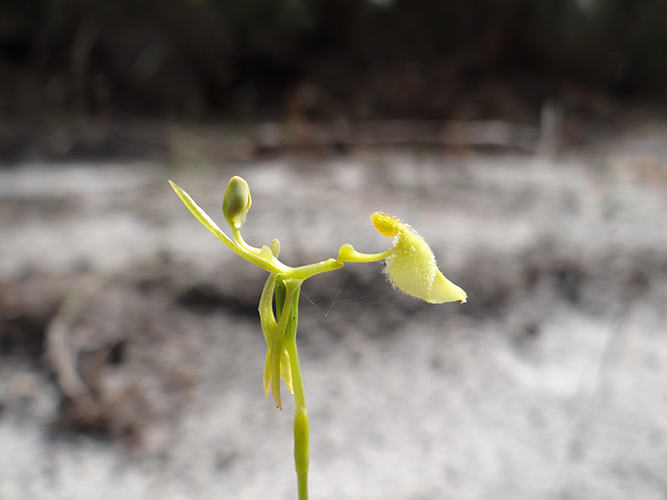
Drakaea glyptodon yellow form – Ryan Phillips
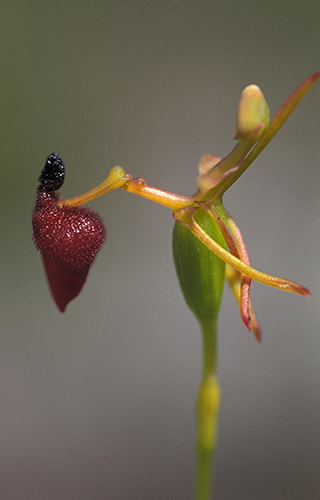
Drakaea glyptodon typical form – Kingsley Dixon
